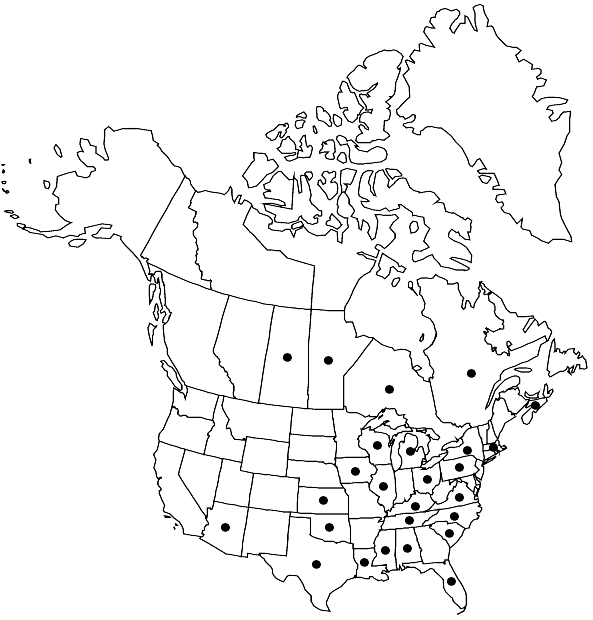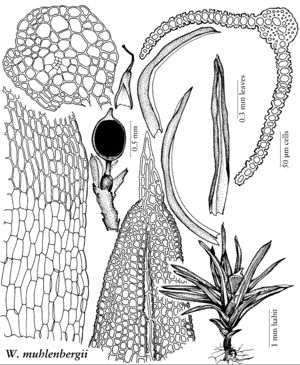Difference between revisions of "Weissia muehlenbergiana"
Bryologist 68: 282. 1965,.
TammyCharron (talk | contribs) |
TammyCharron (talk | contribs) |
||
| Line 1: | Line 1: | ||
{{Treatment/ID | {{Treatment/ID | ||
| − | |accepted_name=Weissia | + | |accepted_name=Weissia muhlenbergiana |
|accepted_authority=(Swartz) W. D. Reese & B. A. E. Lemmon | |accepted_authority=(Swartz) W. D. Reese & B. A. E. Lemmon | ||
|publications={{Treatment/Publication | |publications={{Treatment/Publication | ||
| Line 7: | Line 7: | ||
}} | }} | ||
|basionyms={{Treatment/ID/Basionym | |basionyms={{Treatment/ID/Basionym | ||
| − | |name=Phascum | + | |name=Phascum muhlenbergianum |
|authority=Swartz | |authority=Swartz | ||
|rank=species | |rank=species | ||
| Line 14: | Line 14: | ||
}} | }} | ||
|synonyms={{Treatment/ID/Synonym | |synonyms={{Treatment/ID/Synonym | ||
| − | |name=Astomum | + | |name=Astomum muhlenbergianum |
|authority=(Swartz) Grout | |authority=(Swartz) Grout | ||
|rank=species | |rank=species | ||
}} | }} | ||
| − | |hierarchy=Pottiaceae;Pottiaceae subfam. Trichostomoideae;Weissia;Weissia | + | |hierarchy=Pottiaceae;Pottiaceae subfam. Trichostomoideae;Weissia;Weissia muhlenbergiana |
| − | |hierarchy_nav=<div class="higher-taxa"><div class="higher-taxon"><small>family</small>[[Pottiaceae]]</div><div class="higher-taxon"><small>subfamily</small>[[Pottiaceae subfam. Trichostomoideae]]</div><div class="higher-taxon"><small>genus</small>[[Weissia]]</div><div class="higher-taxon"><small>species</small>[[Weissia | + | |hierarchy_nav=<div class="higher-taxa"><div class="higher-taxon"><small>family</small>[[Pottiaceae]]</div><div class="higher-taxon"><small>subfamily</small>[[Pottiaceae subfam. Trichostomoideae]]</div><div class="higher-taxon"><small>genus</small>[[Weissia]]</div><div class="higher-taxon"><small>species</small>[[Weissia muhlenbergiana]]</div></div> |
|volume=Volume 27 | |volume=Volume 27 | ||
|mention_page=page 513, 516 | |mention_page=page 513, 516 | ||
| Line 32: | Line 32: | ||
|elevation=moderate elevations | |elevation=moderate elevations | ||
|distribution=Man.;N.S.;Ont.;Que.;Sask.;Ala.;Ariz.;Fla.;Ill.;Iowa;Kans.;Ky.;La.;Mass.;Mich.;Miss.;N.Y.;N.C.;Ohio;Okla.;Pa.;S.C.;Tenn.;Tex.;Va.;Wis.;e Asia. | |distribution=Man.;N.S.;Ont.;Que.;Sask.;Ala.;Ariz.;Fla.;Ill.;Iowa;Kans.;Ky.;La.;Mass.;Mich.;Miss.;N.Y.;N.C.;Ohio;Okla.;Pa.;S.C.;Tenn.;Tex.;Va.;Wis.;e Asia. | ||
| − | |discussion=<p>As with <i>Weissia ludoviciana</i>, the gametophyte of <i>W. | + | |discussion=<p>As with <i>Weissia ludoviciana</i>, the gametophyte of <i>W. muhlenbergiana</i> is like that of <i>W. brachycarpa</i>, but differs to some extent in the distal leaf margins occasionally sharply inflexed. If the sporophyte has a hybrid origin, then the archegoniate parent has characteristics of both <i>W. controversa</i> and <i>W. brachycarpa</i>. The hybrid W. muhlenbergiana × <i>W. controversa</i> was reported by C. Williams (1966).</p> |
|tables= | |tables= | ||
|references= | |references= | ||
| Line 40: | Line 40: | ||
-->{{#Taxon: | -->{{#Taxon: | ||
| − | name=Weissia | + | name=Weissia muhlenbergiana |
|authority=(Swartz) W. D. Reese & B. A. E. Lemmon | |authority=(Swartz) W. D. Reese & B. A. E. Lemmon | ||
|rank=species | |rank=species | ||
|parent rank=genus | |parent rank=genus | ||
| − | |synonyms=Astomum | + | |synonyms=Astomum muhlenbergianum |
| − | |basionyms=Phascum | + | |basionyms=Phascum muhlenbergianum |
|family=Pottiaceae | |family=Pottiaceae | ||
|phenology=Capsules mature winter–spring. | |phenology=Capsules mature winter–spring. | ||
| Line 58: | Line 58: | ||
|subfamily=Pottiaceae subfam. Trichostomoideae | |subfamily=Pottiaceae subfam. Trichostomoideae | ||
|genus=Weissia | |genus=Weissia | ||
| − | |species=Weissia | + | |species=Weissia muhlenbergiana |
}}<!-- | }}<!-- | ||
Revision as of 16:57, 19 May 2021
Leaves long-lanceolate, base little differentiated to triangular or narrowly elliptic, shoulders absent, distal laminal margins plane or erect, apex broadly channeled or plane, acute, mucro very strong, of 6–10(–14) cells; costal adaxial stereid band smaller than the abaxial; distal laminal cells 8–10 µm wide. Sexual condition cladautoicous. Seta very short, less than 0.05 cm not including the vaginula. Capsule cleistocarpic, round, with a short-rostrate or conic, occasionally angled or curved apiculus.
Phenology: Capsules mature winter–spring.
Habitat: Soil, lawns, fields, among grasses, roadsides
Elevation: moderate elevations
Distribution

Man., N.S., Ont., Que., Sask., Ala., Ariz., Fla., Ill., Iowa, Kans., Ky., La., Mass., Mich., Miss., N.Y., N.C., Ohio, Okla., Pa., S.C., Tenn., Tex., Va., Wis., e Asia.
Discussion
As with Weissia ludoviciana, the gametophyte of W. muhlenbergiana is like that of W. brachycarpa, but differs to some extent in the distal leaf margins occasionally sharply inflexed. If the sporophyte has a hybrid origin, then the archegoniate parent has characteristics of both W. controversa and W. brachycarpa. The hybrid W. muhlenbergiana × W. controversa was reported by C. Williams (1966).
Selected References
None.
